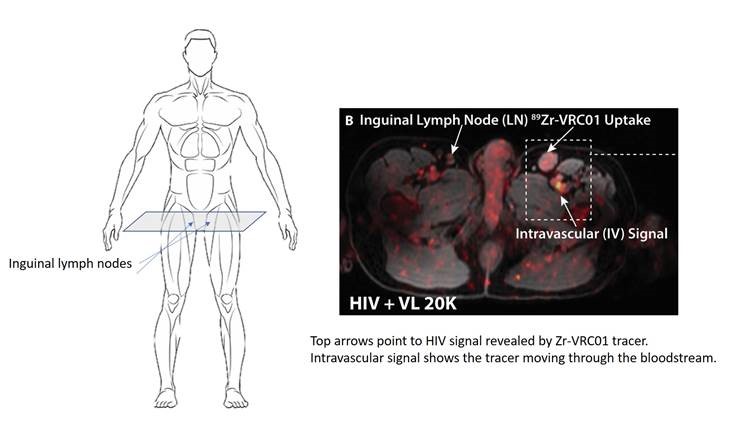Using PET Scans to Visualize HIV
By Jeffrey Laurence, M.D.
How do researchers look for disease in the body? One method is commonly used by physicians for the same purpose: a PET (positron emission tomography) scan, which uses a small amount of radioactive substance called a tracer that gives scientists a visual once it travels through the bloodstream and collects in organs and tissues.
Research question
HIV largely resides in parts of the body such as organs and tissues that, unlike blood, are difficult to sample, and so the development of non-invasive ways to examine HIV in these sites would be invaluable.
Findings
The authors chemically joined an antibody capable of binding to the HIV envelope with a radioactive element, zirconium-89, which can be used as a tracer in standard medical PET scans. This “immunoPET” technique was used to examine five uninfected control individuals, five people living with HIV (PLWH) who were not on antiretroviral therapy (ART), and five PLWH on effective ART ranging from 3 months to more than 18 years. HIV was found primarily in the lymph nodes and intestines, regardless of HIV treatment status. However, the intensity of signal, indicating a greater viral burden, was much stronger in those not taking ART.

These signals corresponded to areas of HIV p24 antigen expression in patients who underwent tissue biopsy, indicating that PET scanning appears to align with findings derived from the more arduous biopsy process. Areas not typically biopsied, such as the testes, were negative on the scans in both groups of PLWH. Notably, as in prior animal studies, the nasal passages—not commonly thought of as a reservoir for HIV—also lit up in these PET scans. One limitation of the procedure is that this HIV tracer could not cross into the brain, so the brain could not be examined for virus.
Impact
The authors concluded that their strategy may permit non-invasive longitudinal characterization of HIV infection in tissues. The authors also determined the strategy could work in the study of other infectious diseases.
amfAR’s role
amfAR was a funder of this research.
Original article
http://www.ncbi.nlm.nih.gov/pubmed/35264559
Dr. Laurence is amfAR’s senior scientific consultant.
Share This:
